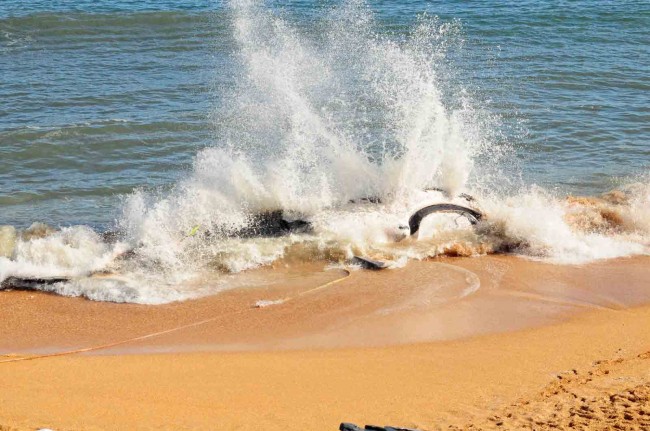
Last Updated: 7:43 p.m.
A 26-foot right whale–a species so critically endangered that there are only about 500 sch whales left–was discovered beached in the area south of Varn Park in Beverly Beach in Flagler County this morning. The whale was dead, and may have died two or three days ago. The cause of death is unknown at the moment.
The scene, tragic and disturbing in most people’s eyes, was roped off by authorities, which include the Florida Fish and Wildlife Commission, the Marineland Conservation Center, the National Oceanic and Atmospheric Administration Fisheries, representatives of the Georgia Aquarium (owner the Marineland attractions) and others.
Troy Harper, Flagler County’s emergency operations director, coordinated the response this morning. He said scientists are in the process of conducting a necropsy of the whale, while the Florida Division of Environmental Protection has given authorization to bury the whale in place, “if feasible,” Harper said. S.E. Cline Construction, the Palm Coast-based contractor, was hired to conduct the operation with heavy equipment. The burial should be completed around sundown, Harper said.
“My advice is stay off the beach and look them up on line because it’s chaotic over there,” Harper said, noting that several dozen scientists and other personnel are at the scene working, with construction on A1A only adding to mess. “So we really discourage folks to go down to the area of the beach specifically to look at the whale.”
The whale is adjacent to private property, so the only way to reach it is for people to park at Varn Park and walk south, though only as far as the rope-off. The whale had been on dry land this morning, but the tide was rising (high tide was at 1 p.m.).
Harper said the scene may be disturbing to some, but may only get worse as scientists get to work, dismembering the creature for burial. “It’s going to stop looking like a whale very quickly here,” Harper said.
NOAA Fisheries Service, a federal agency, is the lead agency in charge of the scene, under the direction of Barb Zoodsma.
“What we have here is a 26-foot long dead North Atlantic right whale,” Zoodsma said. “It stranded during the night sometime. It was reported yesterday afternoon by a boater offshore, a couple of miles offshore. Don’t know why it’s dead. We’ll be performing a necropsy to determine the cause of death.” Additional agencies at the scene include the U.S. Geological Survey and personnel from Seaworld, the University of Florida and the University of North Carolina at Wilmington. “A right whale is a big endeavor so it takes a lot of people,” Zoodsma said.
“Right now we’re waiting for the tide to go down a little bit and some heavy equipment to arrive so we can move the animal further up the beach,” Zoodsma said, speaking before 2 p.m., “at which time we’ll start to cut the animal up and try to determine the cause of death.”
NOAA found out about the whale late yesterday afternoon, when “it was too late for us to rally up the resources to tow the animal ashore,” Zoodsma said, “so overnight we had an uncontrolled landing, I’ll call it, of this whale, and so we work with it where it is.”
The whale had an inexplicable rope and bouee tied to its tail.
Only two days ago, a sperm whale, measured at around 40 feet, died near Pompano Beach and washed ashore at the International Fishing Pier in Deerfield Beach. Lifeguards roped the carcass to move it away from the pier, and it was eventually towed offshore. News reports from Deerfield Beach noted that the whale may have been harassed by swimmers in its last moments. WTVJ Channel 6 reported a witness describing one swimmer trying to climb on top of the whale. NOAA was investigating.
Late this afternoon, the Washington, D.C.-based Humane Society of the United States and Whale and Dolphin Conservation reacted with alarm and concern to the whale’s death, saying it follows an incident last week when a vessel struck a right whale northeast of Ossabaw Island, Ga.
“We simply can’t afford to keep losing right whales,” said Sharon Young, marine issues field director for The HSUS. “It’s time that the federal government started taking seriously its obligation to protect this beleaguered species and take action. With a critically endangered species like the right whale, saving every individual we can is crucial to the creation of a better future for them.”
“Officials with the National Oceanic and Atmospheric Administration say the biggest threats these whales face are from vessel strikes and entanglements in commercial fishing gear, but in reality, the biggest threat right whales face is bureaucracy,” said Regina Asmutis-Silvia, executive director of WDC’s North American office. “It’s not too late to save them, but at some point, it will be.”
The groups called on NOAA to take the following actions:
- Extend a federal regulation set to expire on Dec. 9, 2013 that requires vessels to slow in areas where right whales gather seasonally.
- Follow through on a pledge to expand the protected areas of right whale critical habitat — including whales’ calving grounds off the coasts of Georgia and Florida. The agency pledged to do so in response to a petition by WDC, The HSUS and other groups but has not yet taken action.
- Require changes to fishing gear that would reduce fatal entanglements. The regulations are pending with NOAA.
Nevertheless, it is still not known why this right whale died.
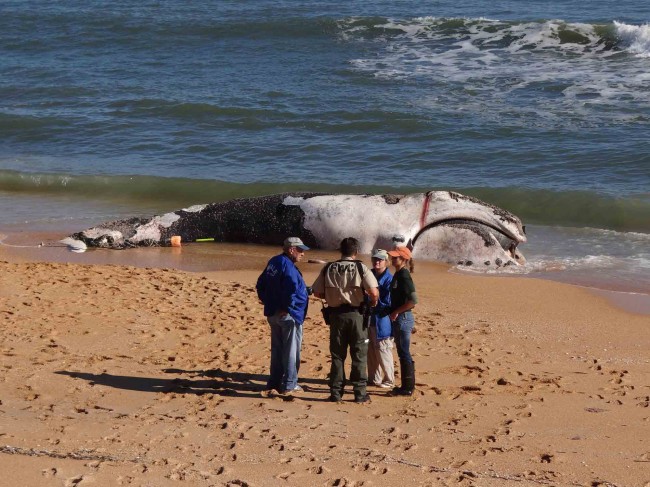

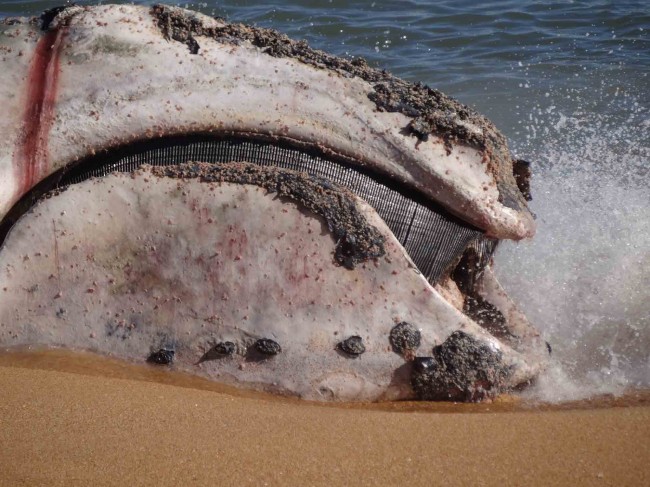
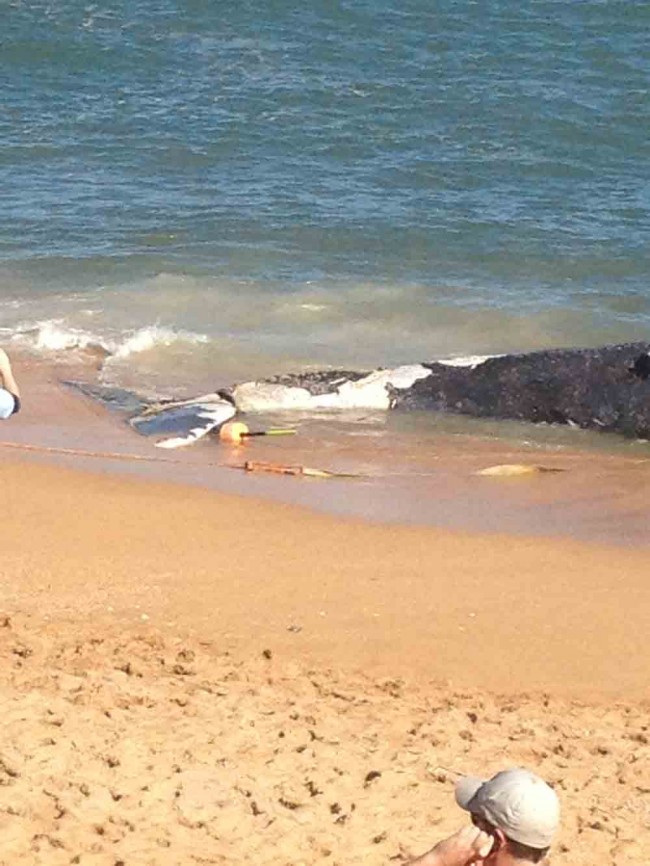

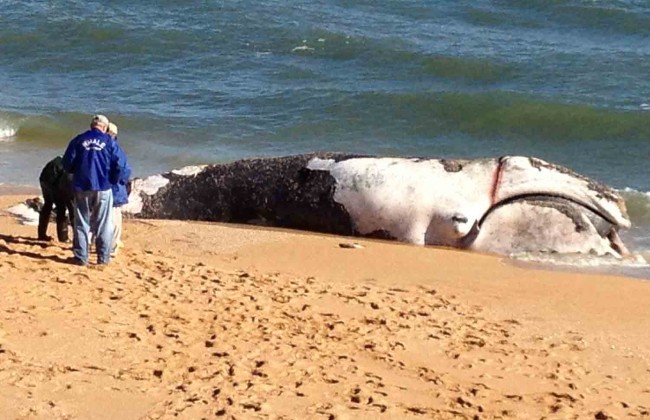
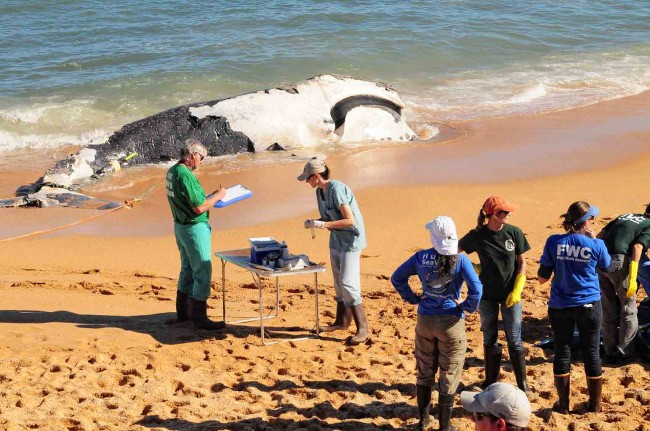
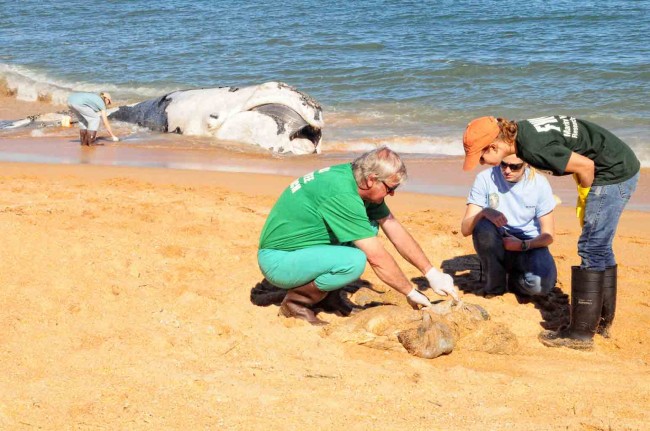
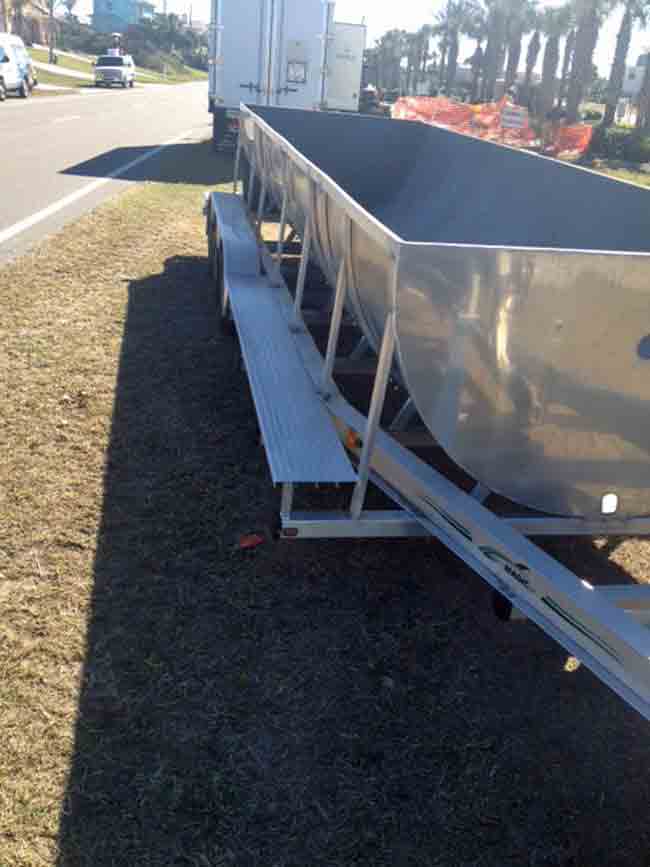





























CHECK PLEASE says
Wow look at those teeth!
Capt Ahab says
A RIGHT whale is categorized as a Baleen whale. Baleen whales are characterized by having baleen plates for filtering food from water, rather than having teeth. Baleen whales are generally larger than toothed whales, and females are bigger than males. This group includes the largest known animal species, the blue whale. Baleen whales have two blowholes, causing a V-shaped blow.
daveytickle says
Teeth? Those things look more like the strainers that these big guys use while they are doing their version of net-fishing! :)
It’s actually hard for me to witness these happenings, but think about it this way. One of these today and one of those tomorrow, and without instantaneous media coverage who would have known that either had happened? Couldn’t this just be a natural death in our WORLD? (I capped world because we are all living in an environment that is changing faster than we can keep up with-an *instantaneous* world of information).
How many of these whales have died for whatever reason in the lifespan of you or me? Over the centuries? From day one?
Yet I still *feel* this death. Indeed I do.
confidential says
Wonder what really happened to that whale with a rope and a floating device on its tale.
Regina Asmutis-Silvia says
WDC, Whale and Dolphin Conservation, is spearheading a campaign entitled Act Right Now, to stop the tragic, and preventable, losses of this endangered species. With fewer than 500 animals remaining, every individual matters. Please help save this species from extinction at http://www.whales.org by adding your name to the WDC petition to keep the ship strike rule in place, increase designated critical habitat, and reduce the risk of entanglement to NA right whales before it’s too late.
MIMI wAITE says
The whale in this video is a North Atlantic Right Whale, dead on a Florida coast. Long treasured by Georgians, it is our state mammal, and it is the most critically endangered of all whales, with a population between 300 and 400 in the entire world. This whale died in the waters where Right Whales come to calve. But we’d better get used to the sight of dead whales on our beaches. A Savannah judge has signed their death warrant by giving the US Navy the right to build a 500 square mile submarine warfare training range off the coast of Georgia. Whales like this one are in grave danger of being deafened and even killed by sonar. Scientists know this from autopsies done on 37 whales that beached themselves off Cape Hatteras after just a few days of military exercises. Our Right Whales, in their calving grounds, will be subject to continuous sonar over the 20 year lifespan of this warfare range. We had better prepare for heavily increased traffic from surface ships as well as jet fighter planes, training in war games over our peaceful islands.
This is OK with Judge Wood. She granted the Navy permission to invade the spawning ground of the North Atlantic Right Whale over strenuous objection by environmental groups, even though the Navy admitted “ that sonar training and testing might unintentionally harm marine mammals 2.8 million times a year over five years” in the Pacific. The freighters carrying Mercedes Benz cars must slow to 10 knots, but there is no speed or depth limit on the US Navy and no prohibition from conducting war training during calving season.
So we are virtually guaranteed to see dead whales on our beaches, bleeding from the eyes and ears. Dolphins, too. Are you ready ?